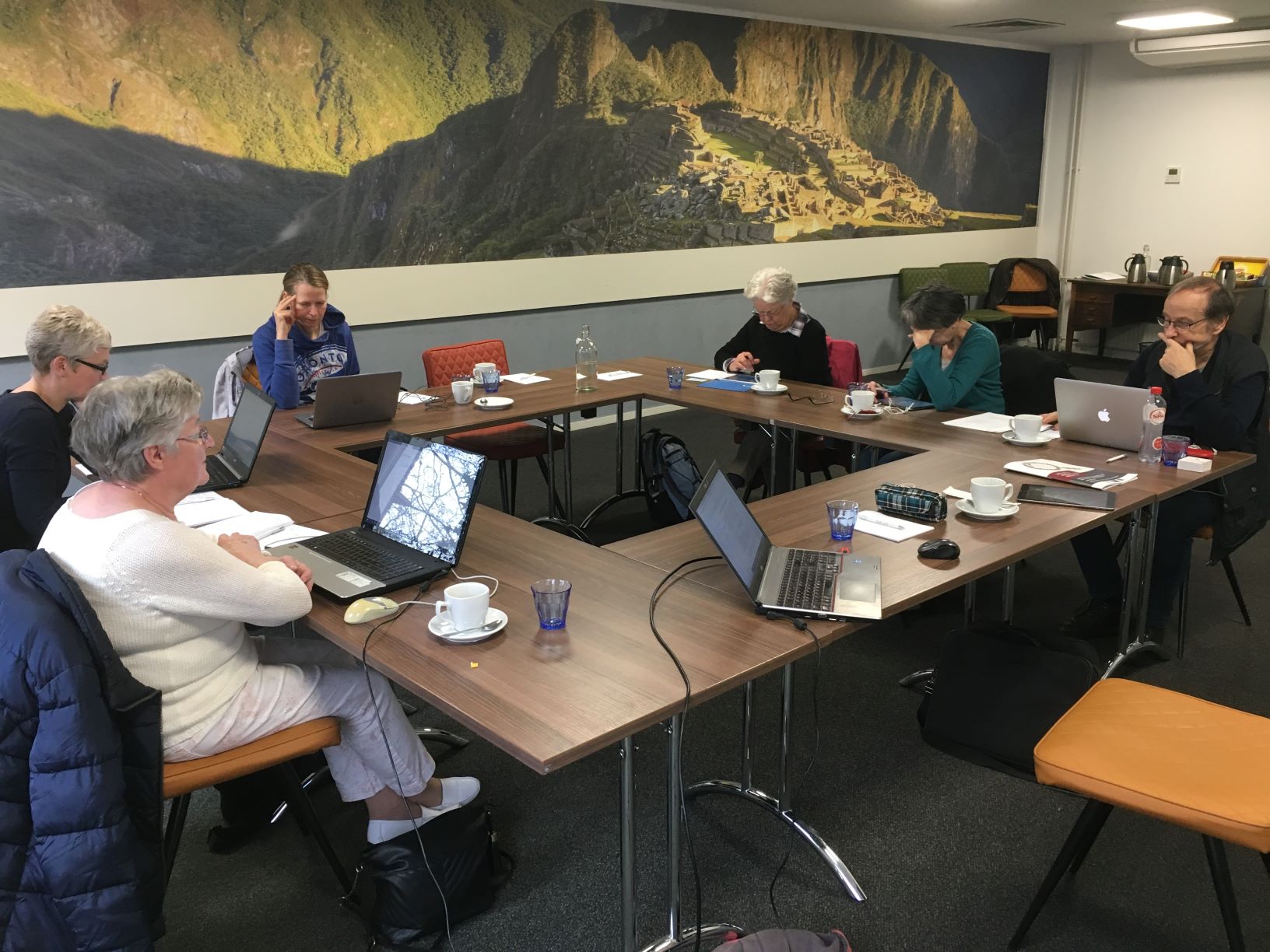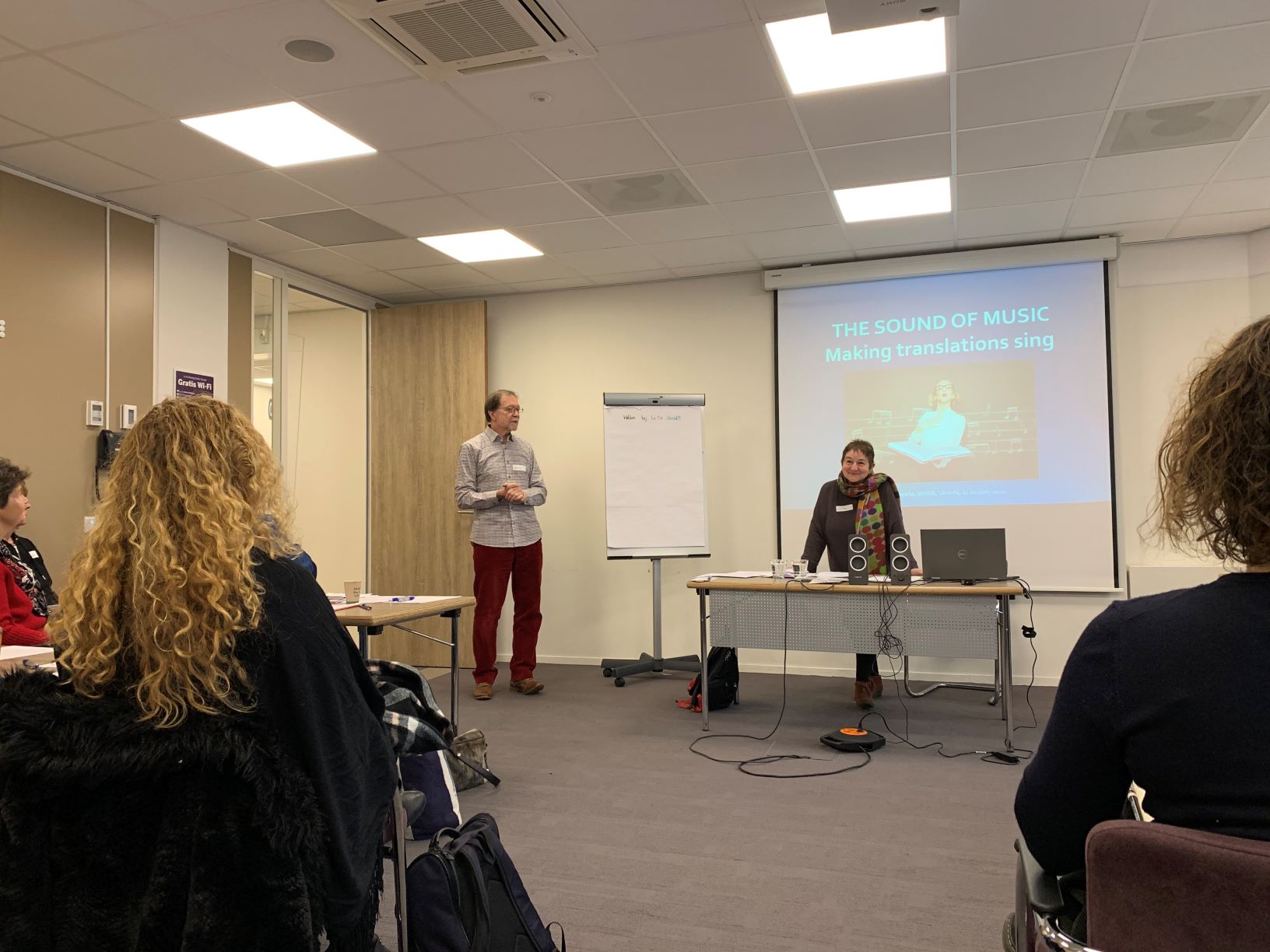 \
\
On January 11, 21 translators met in La Vie in Utrecht for an all day workshop on translating from a writer’s point of view. Ros Schwartz has a background as a translator of French literature, but she’s been helping other translators for twenty years, regardless of which language pair they work in. You might think she ought to have some command of Dutch to be leading a workshop about translating Dutch to English, but it didn’t matter. The point of this workshop was to get us past our connection to the source text and see a translation as a self-sufficient English text. That’s what our clients see, after all.
Ros started out with a PowerPoint presentation entitled ‘The Sound of Music – Making translations sing’. It included some general points (know your audience, take a break before doing the final read-through) and some quite specific ones, even down to one word (‘of’’ – couldn’t the ‘minister of finance’ just be the ‘finance minister’?). One of her key ideas is to ‘take ownership’ of the translation – asking yourself what the client wants to communicate and putting that down instead of literally translating. Taken together, these points are a powerful recipe for delivering better translations.
Next we split into groups of four or five to do a short practice exercise based on these points. We worked on a sample translation that was lacking in out-and-out errors but also in oomph, then discussed it with the full group. Each small group then worked on several texts that had been submitted by other participants in advance. These work sessions were illuminating to say the least. As a rule, the submissions were something the translator had found tricky. Although the problems were usually clear, the key to how to make them sing in English was not obvious. Being armed with some of Ros’ insights did make a difference.
At the end of the day, we shared our findings with the full group. Having colleagues pick your work apart can be terrifying. Ros acknowledged this, comparing it to standing naked in front of everybody, and asked that we make our feedback constructive by saying why something didn’t work and how it could be better. The feedback can be confrontational, but is usually well worth it. It’s also sometimes gratifying to hear that there often isn’t one ‘correct’ translation for a particular word, and that opinions differ on what works and doesn’t work.
Sometimes the problem was not a specific word or words but how the information was arranged: a written-out list might serve your audience better as a bulleted list. Sometimes the source text was not good to begin with. Rather than advocating the ‘garbage in, garbage out’ approach, Ros sees these texts as an opportunity for the translator to take ownership and really shine (tip: point out diplomatically to the client what you’ve done).
I think I can speak for all those participating when I say we left with a little more spring in our step and a few more tools in the tool kit!
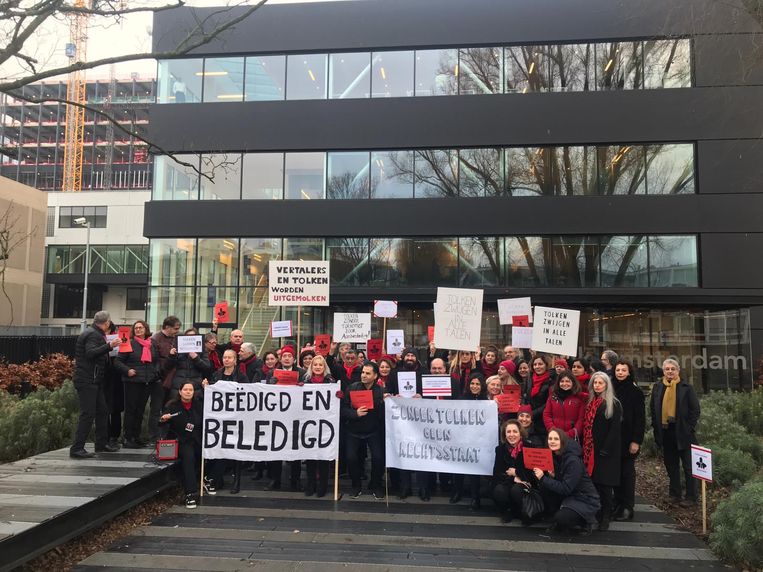
Sworn translators and interpreters protesting in front of the courthouse in Amsterdam on 13 January 2020. Image by Jaike Reitsema.
Although all interpreters do is talk, we’re not known to be very vocal. We are hard-working people who prefer not to be the centre of attention. Many of us work in public service: interpreting for the police, the courts or immigration services. Others specialise in wiretap transcription or healthcare.
Despite lobbying from various organisations that support public service interpreters and translators, hourly rates have remained the same as they were over 30 years ago. Promises about improving working conditions have never materialised. At the same time, the requirements for entry in the register of sworn/certified interpreters and translators (Rbtv) have gone up, as have the costs to keep your registration active through regular CPD courses. Many experienced colleagues feel it’s simply impossible to earn a decent income; as independent professionals, their work load is unpredictable. It also involves a lot of travelling, which means interpreters cannot work 40 hours a week. As a result, there is now a shortage of interpreters into a number of languages.
Things came to a head in 2017, when a government report was published with the unsavoury title ‘Don’t tolk too much’ – a play on words involving the Dutch word for ‘interpreter’. The report highlighted the need to streamline availability and lower costs. This resulted in a programme by the Ministry of Justice and Security called ‘Tolken in de toekomst’ ('Interpreting in the future'). Key points: streamlining the way government authorities purchase interpreting and translation services, while also providing room for innovation. Sounds reasonable, doesn’t it?
Unfortunately, the solutions the Ministry proposed (and the position they took in online consultations and face-to-face meetings with stakeholders) have baffled and angered professional interpreters and translators:
- Further outsourcing of interpreting and translation services currently handled by in-house planners. The first pilots are already running: interpreters are now also being called in for court hearings via intermediaries – at even lower rates. Obviously, interpreters who refuse to work for these mediators are no longer contacted, so an increasing number of sensitive cases is handled by unqualified interpreters.
- Including B2 speakers in the official register to solve the shortage. Obviously, this was the last straw for many interpreters who spent years studying to get a degree and to get their language skills at C1/C2 level, only to see now that a simple secondary school diploma will be enough. No requirements are specified regarding the professional skills required – simultaneous interpreting, ethics, jargon, et cetera – for entry at B2 level, and there are no plans for monitoring and quality control.
- A new payment system, including a minimum rate that hasn’t been indexed since 1984. The current travel expense scheme is downgraded to €0.19(ish) per km, which disregards the fact that interpreters can’t work while travelling. Parking and car maintenance (previously covered by voorrijkosten or call-out charge) are no longer reimbursed.
In early 2019, a group of over 100 interpreters joined forces as Tolken en Vertalers in Actie and contacted a lawyer to see what legal action they could take. After calling in the help of lobbying organisation ZZP Nederland, the group adopted a resolution and announced strikes. In the week of 13-19 January 2020, a large number of interpreters went on strike and demonstrated at various courthouses in the Netherlands to demand attention for their position. This has since resulted in a round-table meeting with MPs of the Justice and Security Committee and questions being posed in Parliament, but Minister Grapperhaus has yet to issue a formal response.
What will the future look like for public service interpreters and translators? A lot is still unsure, but we will continue to fight for fair compensation and proper regulation of the profession. The next strike is planned for 19 February at Plein 2, The Hague – the date of the debate between the Minister and the committee. For more information, contact Tolken en Vertalers in Actie.
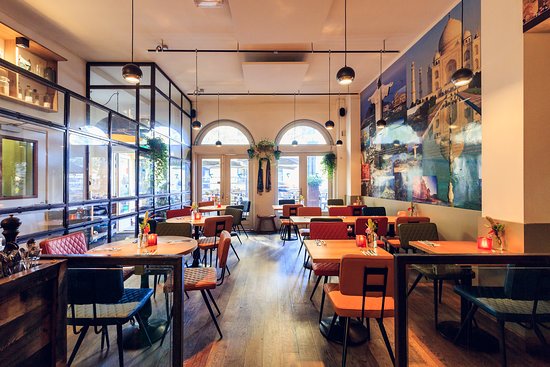
In this new blog series, we will highlight the different Special Interest Groups (SIGs) SENSE has to offer. SIG meetings are open to all members, and guests are welcome to attend one or two meetings before deciding whether they would like to join SENSE. Check the events calendar for upcoming SIG meetings. Contact the SIG convener for more information or to suggest a meeting topic. If you would like to start a new SIG, contact our SIG and Social Events Coordinator. SenseMed convener Curtis Barrett kicks off:
Can you tell us a little about yourself?
I’m an American, born and raised. I moved here in 2007 to continue my career as a neurobiologist, working as a group leader at Leiden University Medical Center (LUMC). In 2011, I left the research world and started my freelance editing and consulting business, helping fellow scientists and clinicians publish their research and obtain grants. In addition, I have a permanent position as a lecturer at Wageningen UR, where I teach scientific writing to MSc and PhD students.
What is SenseMed and who is it for?
SenseMed is a special interest group that focuses on bringing together SENSE members with clients in the medical and biomedical fields. In a nutshell, SenseMed provides a forum where like-minded editors, translators, and medical writers can exchange ideas, discuss the latest trends and challenges in publishing and funding, help de-mystify obscure medical terminology, and more.
How did SenseMed get started?
SenseMed was started by SENSE members Josefien Bruijn, Julie Box and Daphne Lees to connect members with questions related to medical terminology. For years, SenseMed was strictly email-based, with members joining a Yahoo! mailing list to exchange questions and answers. With the growing ease and power of search engines, however, participation in the mailing list declined, so last year we closed the mailing list and now encourage members to post their queries on the members-only Forum.
How often does SenseMed meet up?
That’s a good question! Actually, with the exception of one event about six years ago, SenseMed has never met at a physical location, and that’s something we’re hoping to change. Our goal is to organize two to three meetings each year.
How many people generally attend SenseMed meetings?
We’ve never really met, but our target is to draw a group of around 20.
When and where will the next SenseMed meeting be?
Thursday 20 February, 2020 from 16:30-18:30, at Restaurant Se7en in Utrecht.
Interested in joining the SenseMed meeting? Register here!
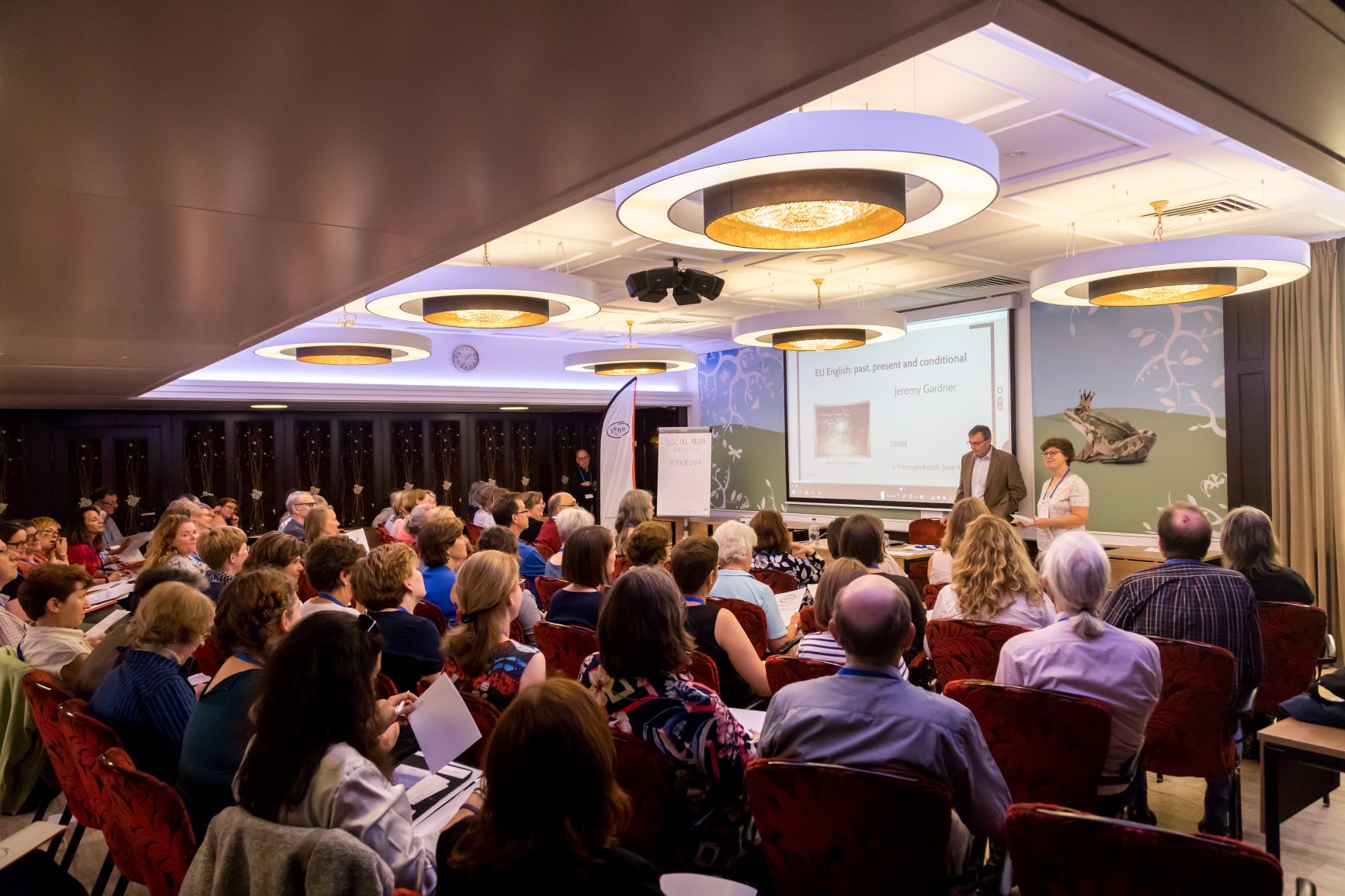
Photo by Michael Hartwigsen
There is no shortage of conference accommodation in the Netherlands, so choosing one just requires a map of the country and a pin, right? Wrong, especially if it’s for the SENSE biennial conference…
Two years ago, I was asked to recommend a location for the 2018 conference. It was quite a challenge, but eventually the decision went in favour of ’s-Hertogenbosch – not because it was a city nobody could spell, but because it offered the right combination of facilities that discerning SENSE members expected.
So what is the ideal location for our conference? In short, there isn’t one, as everyone has his or her preferences. Some of us want a city location with good public transport connections, others want a monastery in the middle of nowhere with free parking, no distractions, and waking up to bird song. As we are becoming a more international event, simply choosing a place that is accessible by train, bus or bike is not enough.
Starting last January (yes, January 2019!), I longlisted almost fifty locations that, in my experience with other conferences, would be suitable. These included several locations suggested by other SENSE members. I shortlisted this to twelve. Of those twelve, five did not have availability, offered a ridiculously high rate or simply failed to respond. Finally it came down to a straight contest: Rotterdam or Maastricht. My personal recommendation was for Maastricht, partly because they had come in second place in 2018, and were very, very keen to have us this time.
During the summer, several of the conference committee members visited the location, viewed the facilities and spoke to the staff. In the end, Maastricht won, but as a consolation prize Rotterdam got the Eurovision Song Contest!
Price is not the only issue, though of course this is a major consideration. Flexibility is most important. I had to explain to all the potential locations that if I was organizing a conference for a major national/international/multinational company, I could tell them immediately how much accommodation we would need, safe in the knowledge that the organizers would pick up the tab. It’s quite unusual for conference locations to understand that we are all freelancers, we pay our own expenses, and because the event is not during ‘office time’ (in other words, in our own time), SENSE cannot guarantee attendance numbers a year in advance.
Another important consideration was that the location should not charge more for two half days than they would for one full day. That’s a bit of a cheek, as it’s unlikely that they would be able to sell the conference facilities on the Saturday morning or Sunday afternoon, so in true Dutch tradition, it’s a case of ‘twee halen, één betalen’!* My shortlist was limited to locations that were prepared to meet us on this point, and most of them were.
I hope I have found the right location for the 2020 conference. If I have, you may congratulate me in June; if not, it’s the committee’s fault! The planning of the speakers, the programme, the workshops and the other activities is going ahead at full steam. My job is complete, but I’m already looking discretely at locations for 2022 – just in case the committee asks me again!
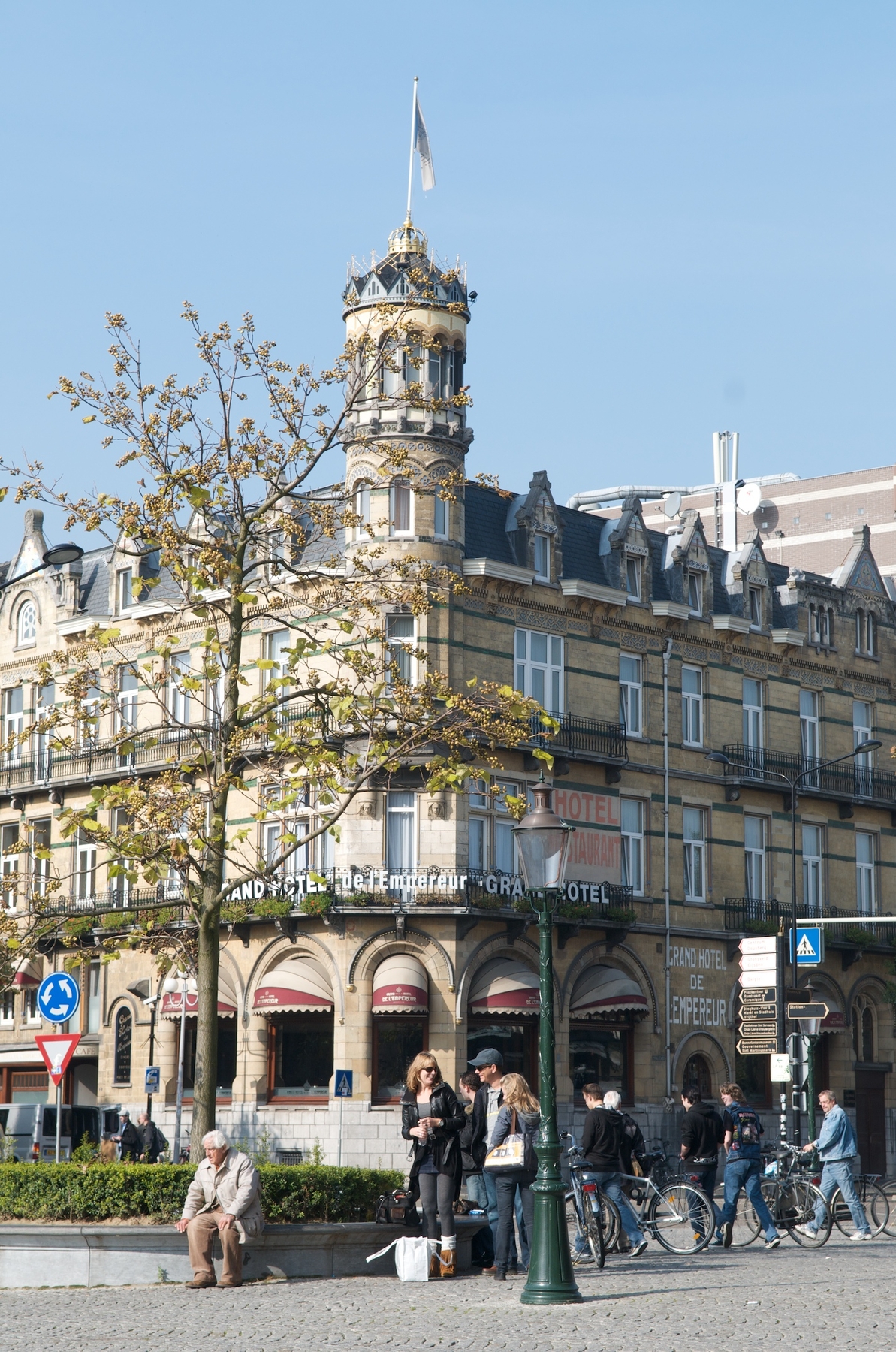
This is where we well be holding the pre-conference workshops and the conference itself: at the four star Amrâth Grand Hotel de l'Empereur in Maastricht. Conference delegates will be able to book a room at the special conference rate once registration for the conference itself opens.
For more information about the conference hotel, see the hotel's website.
Check this page for full details of the conference, location and programme!
© Image by Maastricht Marketing/Jonathan Vos. All rights reserved.
* for non-Dutch speakers, this is the equivalent of ‘Buy one, get one free’.
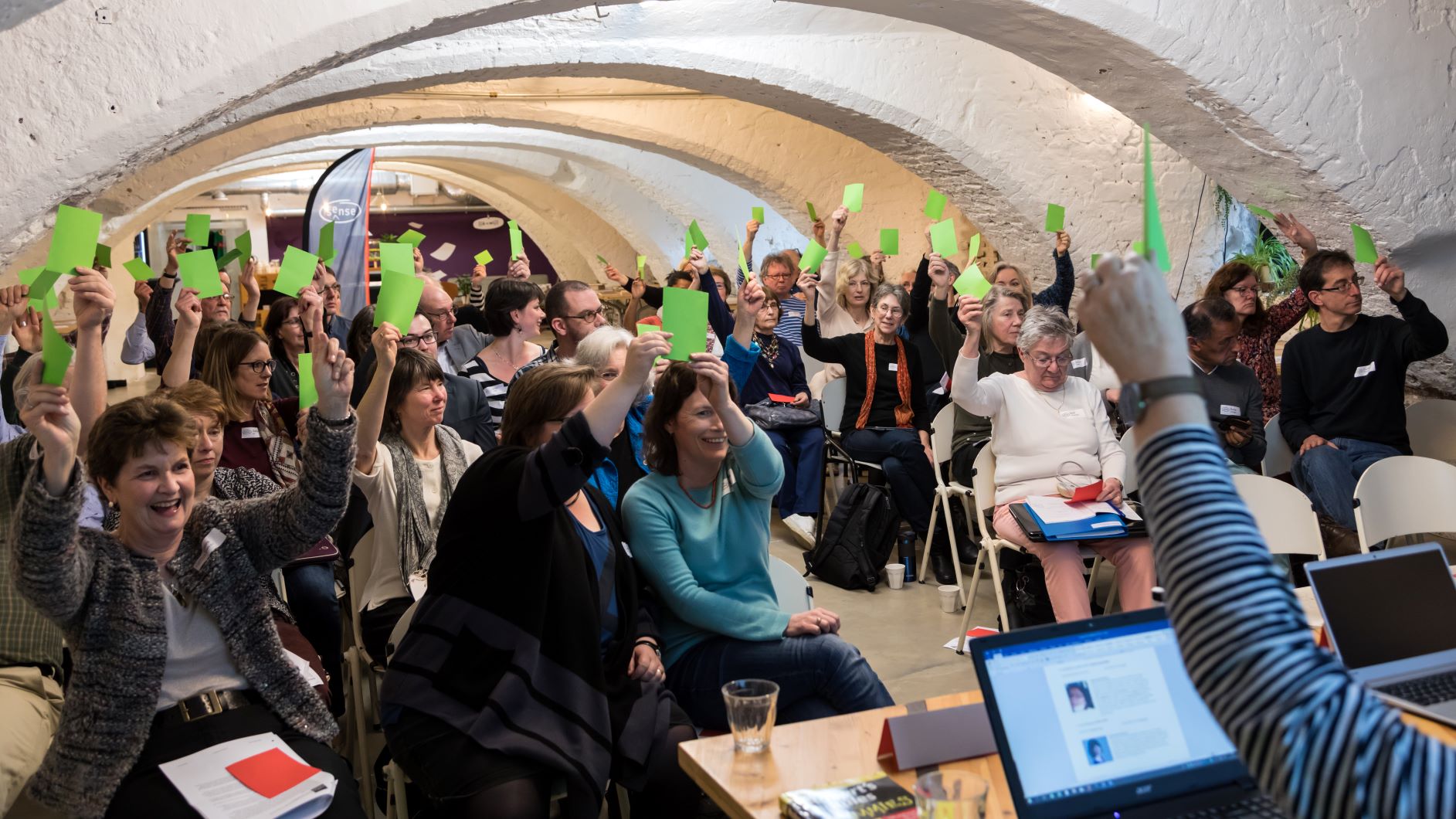
Photo by Michael Hartwigsen
Taking SENSE and making SENSE
We’ve just started a new decade, and SENSE has entered its third decade as a society. So, the time is ripe to broaden the Annual General Meeting's scope and to take it to a new level.
So, what’s on the menu? We’ll start by reviewing the society’s business over the past year: the 'taking SENSE' part. SENSE AGMs have previously been all-afternoon events. Now, in keeping with many other societies, the business part of the meeting will be much shorter (max. 1 hour) with a request to members to submit any questions in writing in advance. A shorter AGM does not mean compromising on our high standards of accountability and scrutiny, but just that the business will be conducted faster and more efficiently.
Now, of course, you’re wondering what will happen with the rest of the time. Well, we’ll use some of it to take a broader look at the society and what we can expect in the coming year: the ‘making SENSE’ part. This will also include an appropriate reflection on our thirtieth anniversary. Then we’ll take a leap into the wider world of language professionals by treating you to a talk by Claire King. She will be providing the English voice-overs for the Eurovision Song Contest later this year in Rotterdam.
Fortunately, some things are too good to change. Therefore, the afternoon will be rounded off with drinks and nibbles, giving you plenty of time to relax and chat with fellow members.
You can read the provisional timetable for the afternoon below, but first a word about this year’s location. We have chosen to host the AGM at Kargadoor, a cultural podium in the heart of Utrecht. By renting the facilities at Kargadoor, SENSE is supporting the highly diverse programme of cultural events offered there. We have the large room on the ground floor, which includes plenty of space for the traditional pre-AGM book swap.
Provisional timetable
13:45 doors open – book swap and tea & coffee available
14:15 AGM business part (taking SENSE)
15:15 AGM looking ahead (making SENSE)
15:35 AGM tokens of appreciation for SENSE volunteers
15:40 Tea and coffee break
16:00 30 years of SENSE
16:20 Talk by Claire King
16:50 Members’ questions to Claire King
17:00 Wrap-up, followed by drinks and nibbles
Please note that the AGM is open to all SENSE members and the programme is free of charge.
The SENSE EC looks forward to welcoming you all at this year’s AGM. Further information about the business part of the AGM and the rest of the afternoon will be sent to members in the coming weeks.
Dave Thomas
SIG and Social Events Coordinator
In early December 2019, both the Ed SIG and UniSIG focused on academic writing. Below, Marianne Orchard reports back from the UniSIG presentation on editing texts for the humanities and social sciences. Jackie Senior tells us how the SENSE Ed SIG members discussed the use of online resources for academic writing.
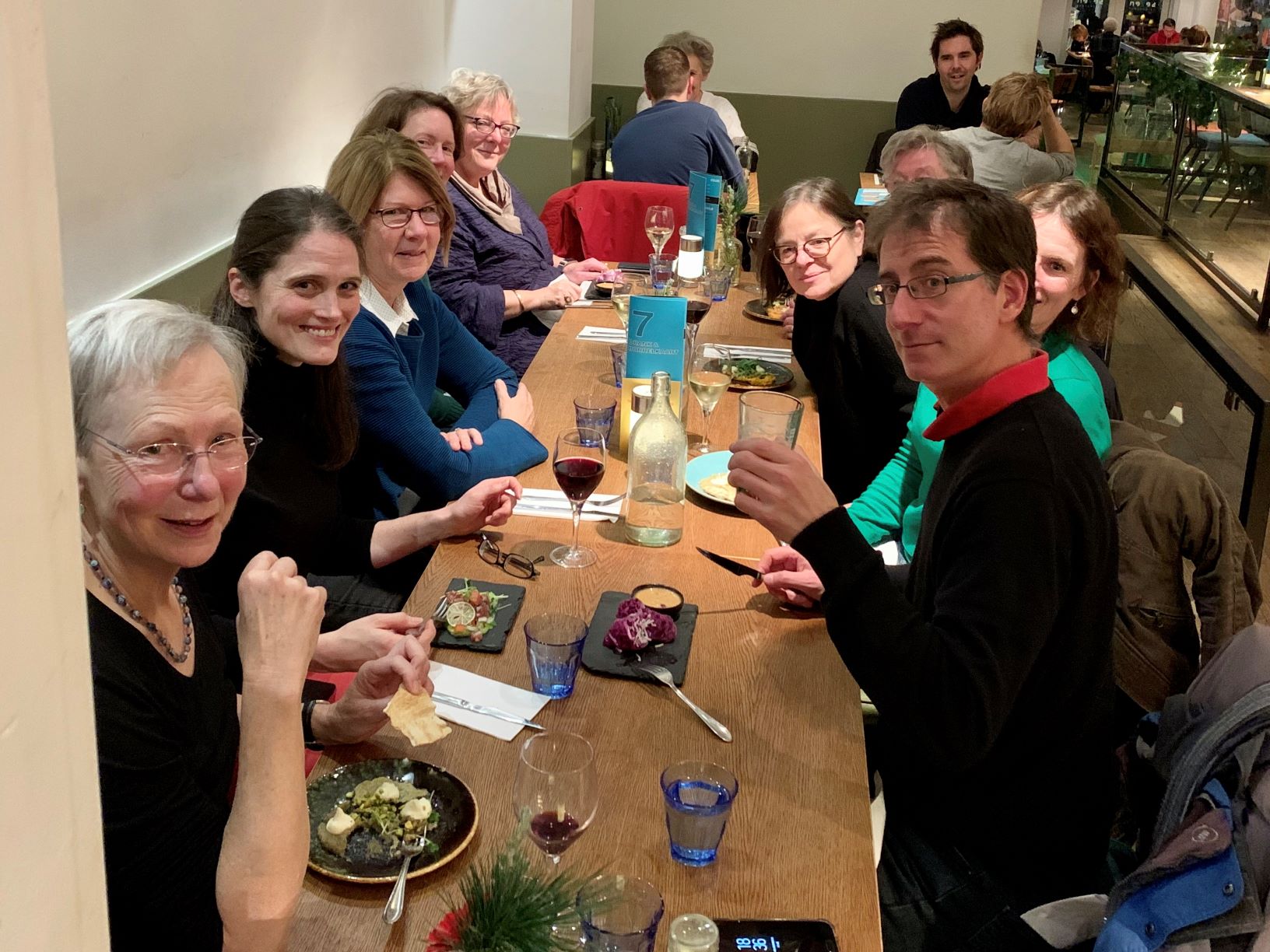
Photo by Theresa Truax-Gischler
UniSIG: Editing humanities and social science texts: theory and practice (Marianne Orchard)
Fourteen of us turned up for the UniSIG meeting at Se7en in Utrecht on Friday 13 December – as if we’d thought the venue would only accept multiples of seven. We’d come for a presentation by Theresa Truax-Gischler and Maria Sherwood-Smith on the American Council of Learned Societies’ Guidelines for the Translation of Social Science Texts.
The guidelines, Theresa explained, were developed to help those who commission edits and translations. ‘Given the potential of the social sciences to influence … millions of lives’, they declare, ‘it is incumbent upon both translator and editor to produce the most reliable translation possible.’
But what is a reliable translation or edit? Should you domesticate or foreignize? Maria had faced this conundrum when translating a Dutch book on 19th-century correspondence. In a more cerebral version of Snog Marry Avoid? she had had to decide whether to translate, gloss or borrow archaic forms of address such as uedele, wel edele and gij.
And given the importance of storytelling and voice in the social sciences, should you level stylistic peculiarities or allow a note of foreignness to enter the text? And what about errors in the source text? Translators and editors, say the guidelines, ‘…must not attempt to correct what they perceive to be errors in the text.’
We decided it boils down to whether you privilege the source text, as the guidelines prescribe, or the target text. However, as many of us have a direct relationship with the author, perhaps we are like quantum particles and can exist in two states at once: as both author’s and reader’s editor/translator.
Photo by David Barick
SENSE Ed: Online Resources for Academic Writing (Jackie Senior)
First, David Barick reported briefly on the EU-MIRoR conference (Methods in Research on Research) that he’d attended in Paris. This project aims to reduce wasteful clinical research and increase the value of research practice. Then we moved on to the main subject of the afternoon: discussing the numerous online resources for learning about writing in English and about academic writing. Such resources need to be chosen carefully to match the learners’ individual needs and the course being given: no easy task given the number of websites available. It is essential to first specify who will be using the resource, at what level, and for what purpose.
David provided a list of resources and we looked at some together. These included the Springer, Purdue University, Columbia University and CARS model websites. As these are generally large, text-based websites, selecting what to look at was sometimes rather difficult. We had a lively discussion on some of the advice given (so many language professionals, so many opinions) and then we did some of the online tests offered to students for them to check what they had learnt. However, we found we sometimes needed more than one go to work out what the correct answer was. This highlights one of the difficulties for students using websites on their own: there’s not always an explanation of what they’ve done ‘wrong’. A face-to-face teacher can point students in the right direction.
We found each website missed some points we would have expected to be covered, for example, the use of the passive, nominalization, writing for a specific field, or relating the instruction to the student’s native language and to their concept of formal writing. We then looked at the AWL (academic word list) Highlighter. This tool highlights the formal words used in academic texts and gives the writer an idea of how much they are using the correct sort of vocabulary. It also offers help on meaning and pronunciation.
For the second half of the afternoon, we looked at videos that explained aspects of academic writing. Some of these were less than inspiring and consisted only of a person talking to the camera, while others (e.g. a TED talk on How to use semicolons) used visuals to attract attention and explain more complex points. Several videos were rather simple and proved a slow way of gathering information (since many people can read a text more quickly than listening to a speaker).
In the end, recommending one website over another proved rather difficult. We finished on a lighter note with the suggestion that all writers and students should watch Helen Sword’s YouTube video on Zombie Nouns, and follow her advice on writing vigorous, verb-driven sentences.
Please consult the SENSE Members’ Forum to see a complete list of resources used during the SENSE Ed SIG meeting.
